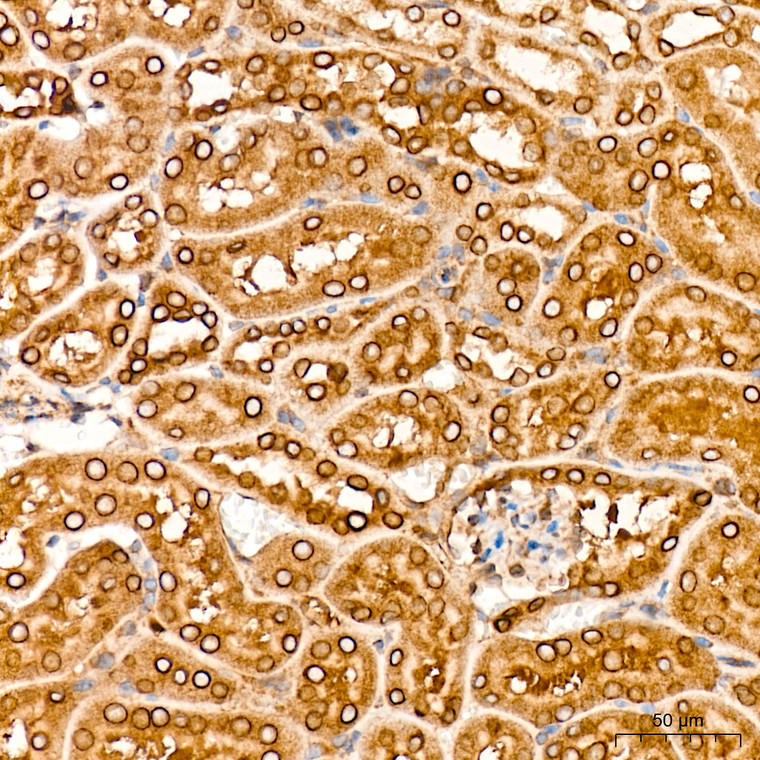-
Western blot analysis of extracts of various cell lines, using RanGAP1 rabbit monoclonal antibody (STJ11102370) at 1:1000 dilution. Secondary antibody: HRP Goat Anti-rabbit IgG (H+L) at 1:10000 dilution. Lysates/proteins: 25ug per lane. Blocking buffer: 3% non-fat dry milk in TBST. Detection: ECL Basic Kit. Exposure time: 3min.
-
Immunofluorescence analysis of U-2 OS cells using RanGAP1 Rabbit monoclonal antibody (STJ11102370) at dilution of 1:100 (40x lens). Secondary antibody: Cy3 Goat Anti-Rabbit IgG (H+L) at 1:500 dilution. Blue: DAPI for nuclear staining.
-
Immunohistochemistry of paraffin-embedded rat testis using RanGAP1 rabbit monoclonal antibody (STJ11102370) at dilution of 1:100 (40x lens). Perform microwave antigen retrieval with 10 mM Tris/EDTA buffer pH 9. 0 before commencing with immunohistochemistry staining protocol.
-
Immunofluorescence analysis of NIH-3T3 cells using RanGAP1 Rabbit monoclonal antibody (STJ11102370) at dilution of 1:100 (40x lens). Secondary antibody: Cy3 Goat Anti-Rabbit IgG (H+L) at 1:500 dilution. Blue: DAPI for nuclear staining.
-
Immunohistochemistry of paraffin-embedded human placenta using RanGAP1 rabbit monoclonal antibody (STJ11102370) at dilution of 1:100 (40x lens). Perform microwave antigen retrieval with 10 mM Tris/EDTA buffer pH 9. 0 before commencing with immunohistochemistry staining protocol.
-
Immunofluorescence analysis of C6 cells using RanGAP1 Rabbit monoclonal antibody (STJ11102370) at dilution of 1:100 (40x lens). Secondary antibody: Cy3 Goat Anti-Rabbit IgG (H+L) at 1:500 dilution. Blue: DAPI for nuclear staining.
-
Immunohistochemistry of paraffin-embedded mouse spinal cord using RanGAP1 rabbit monoclonal antibody (STJ11102370) at dilution of 1:100 (40x lens). Perform microwave antigen retrieval with 10 mM Tris/EDTA buffer pH 9. 0 before commencing with immunohistochemistry staining protocol.
-
Immunohistochemistry analysis of RanGAP1 in paraffin-embedded mouse kidney tissue using RanGAP1 Rabbit monoclonal antibody (STJ11102370) at a dilution of 1:200 (40x lens). High pressure antigen retrieval was performed with 0. 01 M citrate buffer (pH 6. 0) prior to immunohistochemistry staining.
-
Immunofluorescence analysis of C6 cells using RanGAP1 rabbit monoclonal antibody (STJ11102370) at dilution of 1:100 (40x lens). Blue: DAPI for nuclear staining.
-
Immunohistochemistry analysis of RanGAP1 in paraffin-embedded rat liver tissue using RanGAP1 Rabbit monoclonal antibody (STJ11102370) at a dilution of 1:200 (40x lens). High pressure antigen retrieval was performed with 0. 01 M citrate buffer (pH 6. 0) prior to immunohistochemistry staining.
-
Immunofluorescence analysis of NIH-3T3 cells using RanGAP1 rabbit monoclonal antibody (STJ11102370) at dilution of 1:100 (40x lens). Blue: DAPI for nuclear staining.
-
Immunohistochemistry analysis of RanGAP1 in paraffin-embedded human colon carcinoma tissue using RanGAP1 Rabbit monoclonal antibody (STJ11102370) at a dilution of 1:200 (40x lens). High pressure antigen retrieval was performed with 0. 01 M citrate buffer (pH 6. 0) prior to immunohistochemistry staining.
-
Immunofluorescence analysis of U-2 OS cells using RanGAP1 rabbit monoclonal antibody (STJ11102370) at dilution of 1:100 (40x lens). Blue: DAPI for nuclear staining.
-
Immunohistochemistry analysis of RanGAP1 in paraffin-embedded mouse brain tissue using RanGAP1 Rabbit monoclonal antibody (STJ11102370) at a dilution of 1:200 (40x lens). High pressure antigen retrieval was performed with 0. 01 M citrate buffer (pH 6. 0) prior to immunohistochemistry staining.
-
Immunohistochemistry analysis of RanGAP1 in paraffin-embedded rat testis tissue using RanGAP1 Rabbit monoclonal antibody (STJ11102370) at a dilution of 1:200 (40x lens). High pressure antigen retrieval was performed with 0. 01 M citrate buffer (pH 6. 0) prior to immunohistochemistry staining.
-
Western blot analysis of various lysates using RanGAP1 Rabbit monoclonal antibody (STJ11102370) at 1:1000 dilution. Secondary antibody: HRP Goat Anti-Rabbit IgG (H+L) (STJS000856) at 1:10000 dilution. Lysates/proteins: 25 Mu g per lane. Blocking buffer: 3% nonfat dry milk in TBST. Detection: ECL Basic Kit. Exposure time: 3min.






















